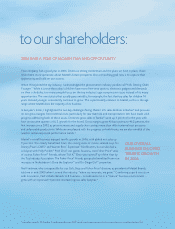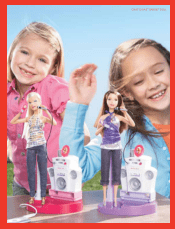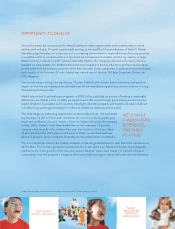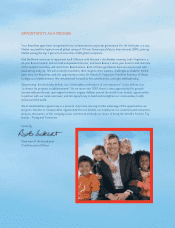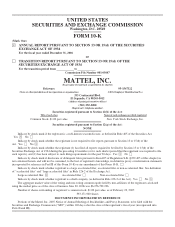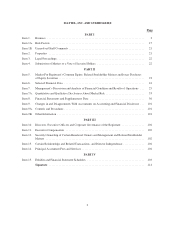Mattel 2006 Annual Report Download - page 12
Download and view the complete annual report
Please find page 12 of the 2006 Mattel annual report below. You can navigate through the pages in the report by either clicking on the pages listed below, or by using the keyword search tool below to find specific information within the annual report.PART I
Item 1. Business.
Mattel, Inc. (“Mattel”) designs, manufactures, and markets a broad variety of toy products worldwide
through sales to its customers and directly to consumers. Mattel’s vision is to provide “the world’s premier toy
brands—today and tomorrow.” Management has set six key company strategies: (i) improve execution of the
existing toy business; (ii) globalize the brands; (iii) extend the brands into new areas; (iv) catch new trends,
create new brands and enter new categories; (v) develop people; and (vi) improve productivity, simplify
processes and maintain customer service levels.
Mattel believes its products are among the most widely recognized toy products in the world. Mattel’s
portfolio of brands and products are grouped in the following categories:
Mattel Girls & Boys Brands—including Barbie®fashion dolls and accessories (“Barbie®”), Polly Pocket!™,
Pixel Chix™,Winx Club™and Disney Classics (collectively “Other Girls Brands”), Hot Wheels®,
Matchbox®and Tyco®R/C vehicles and playsets (collectively “Wheels”) and Batman™, CARS™,
Superman™, Radica:®products, and games and puzzles (collectively “Entertainment”).
Fisher-Price Brands—including Fisher-Price®, Little People®, BabyGear™and View-Master®(collectively
“Core Fisher-Price®”), Sesame Street®, Dora the Explorer™, Go-Diego-Go!™, Winnie the Pooh, InteracTV™
and See ‘N Say®(collectively “Fisher-Price®Friends”) and Power Wheels®.
American Girl Brands—including Just Like You™, the historical collection and Bitty Baby®. American Girl
Brands products are sold directly to consumers and its children’s publications are also sold to certain
retailers.
Mattel was incorporated in California in 1948 and reincorporated in Delaware in 1968. Its executive offices
are located at 333 Continental Blvd., El Segundo, California 90245-5012, telephone number (310) 252-2000.
Business Segments
“Mattel” refers to Mattel, Inc. and its subsidiaries as a whole, unless the context requires otherwise. This
narrative discussion applies to all segments except where otherwise stated. Mattel’s reportable segments are
separately managed business units and are divided on a geographic basis between domestic and international.
The Domestic segment is further divided into Mattel Girls & Boys Brands US, Fisher-Price Brands US and
American Girl Brands.
On October 10, 2005, Mattel announced the consolidation of its domestic Mattel Girls & Boys Brands and
Fisher-Price Brands divisions into one division. The creation of the “Mattel Brands” division, which resulted in
the consolidation of some management and support functions, preserves the natural marketing and design groups
that are empowered to create and market toys based on gender and age groups and is expected to more effectively
and efficiently leverage Mattel’s scale. These changes are consistent with Mattel’s ongoing goals to enhance
innovation and improve execution. In connection with this consolidation, Mattel executed an initiative in 2006 to
streamline its workforce, primarily in El Segundo, California. The consolidation of these divisions did not change
Mattel’s operating segments.
Management believes that the business environment for Mattel for 2007 will be similar to that of 2006.
Mattel expects to continue facing challenges both domestically and internationally as retailers continue to tightly
manage inventory. Additionally, Mattel has experienced continued cost pressures in the areas of product costs,
including oil-based resin and zinc, and employee-related costs. Management believes that Mattel will continue to
encounter a challenging retail environment, along with cost pressures and the possibility of sales declines in the
Barbie®brand.
For additional information on Mattel’s operating segment reporting, including revenues, segment income
and assets, see Item 7 “Management’s Discussion and Analysis of Financial Condition and Results of
3



